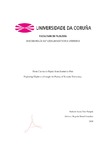Mostrar o rexistro simple do ítem
From Canvas to Paper; from Shutter to Pen: Exploring Ekphrasis through the Poetry of Natasha Trethewey
| dc.contributor.advisor | Simal, Begoña | |
| dc.contributor.author | Tato Pampín, Lucía | |
| dc.contributor.other | Universidade da Coruña. Facultade de Filoloxía | es_ES |
| dc.date.accessioned | 2021-03-08T11:50:40Z | |
| dc.date.available | 2021-03-08T11:50:40Z | |
| dc.date.issued | 2020 | |
| dc.identifier.uri | http://hdl.handle.net/2183/27434 | |
| dc.description.abstract | [Abstract] This paper analyzes a selection of Natasha Trethewey’s ekphrastic poems inspired by both photographs and paintings. The specific nature of each medium offers the possibility to approach ekphrasis from different perspectives, so the examination of the way in which the ekphrastic process is affected by the intrinsic nature of each art constitutes one of the aims that are meant be fulfilled. The importance of contrasting the ekphrastic text with its visual referent is also called into question, becoming the assessment of its (ir)relevance another objective to pursue. The stylistic analysis of the poems will be performed bearing in mind one of the key concepts in cognitive poetics: the figure-ground phenomenon, allowing the evaluation of the suitability of figure-ground dynamics to make sense of the ekphrastic text. Finally, an analysis of the specific uses that the poet devotes to ekphrasis will also be performed. To accomplish the objectives mentioned above, the close reading of the poems is informed by theoretical aspects related to photography, cognitive poetics and, needless to say, ekphrasis itself. A detailed account of such theoretical features is provided in the first chapter, which comprises the definition of the concept of ekphrasis, its historical evolution, its taxonomy, and the decoding process of the ekphrastic text. The chapter also introduces the figure-ground phenomenon and its relevance to the interpretation of the ekphrastic text, while presenting, eventually, some crucial theoretical aspects which shape the photographic phenomenon. The second chapter offers a close reading of three poems inspired by paintings, belonging all of them to Thrall, Trethewey’s poetry collection inspired by casta paintings of eighteenth-century New Spain. The third chapter, on its part, includes the close reading of two poems based on snapshots taken by photographers Clifton Johnson and Ernest J. Bellocq at the dawn of the 20th century, which can be found in Domestic Work and Bellocq’s Ophelia, respectively. The application of those theoretical concepts to the process of close reading has proved eye-opening: it has helped me to understand the complex phenomenon of ekphrasis, thus allowing me to overcome the initial skepticism regarding the potential of ekphrasis to portray a scene whose visual counterpart is absent, just as it does when the text can be contrasted with its visual referent. Furthermore, the stylistic analysis of the texts employing figure-ground dynamics or, more specifically, paying attention to parallel and deviant structures, proves to be helpful when exploring ekphrastic poetry. As for the particularities of each medium and how they condition the approach to the ekphrastic text, in the case of painting, its absolute dependence on human mediation invites the poetic voice to question the intentionality of each detail on the canvas, while theoretical and philosophical aspects seem to constitute the key to interpreting and making sense of Trethewey’s photography-based poems. Finally, Trethewey’s use of ekphrasis, regardless of the medium each poem emerges from, pursues the constant objective of investing with humanity and dignity the individuals who, either through the painter’s brush or the camera lens, undergo a racialized, objectified, or sexualized depiction. | es_ES |
| dc.language.iso | eng | es_ES |
| dc.rights | Os titulares dos dereitos de propiedade intelectual autorizan a visualización do contido deste traballo a través de Internet, así como a súa reproducción, gravación en soporte informático ou impresión para o seu uso privado e/ou con fins de estudo e de investigación. En nengún caso se permite o uso lucrativo deste documento. Estos dereitos afectan tanto ó resumo do traballo como o seu contido Los titulares de los derechos de propiedad intelectual autorizan la visualización del contenido de este trabajo a través de Internet, así como su repoducción, grabación en soporte informático o impresión para su uso privado o con fines de investigación. En ningún caso se permite el uso lucrativo de este documento. Estos derechos afectan tanto al resumen del trabajo como a su contenido | es_ES |
| dc.subject | Trethewey, Natasha | es_ES |
| dc.subject | Ekphrasis | es_ES |
| dc.subject | Photography | es_ES |
| dc.subject | Cognitive Poetics | es_ES |
| dc.title | From Canvas to Paper; from Shutter to Pen: Exploring Ekphrasis through the Poetry of Natasha Trethewey | es_ES |
| dc.type | info:eu-repo/semantics/bachelorThesis | es_ES |
| dc.rights.access | info:eu-repo/semantics/openAccess | es_ES |
| dc.description.traballos | Traballo fin de grao (UDC.FIL). Inglés: estudios lingüísticos y literarios. Curso 2019/2020 | es_ES |






